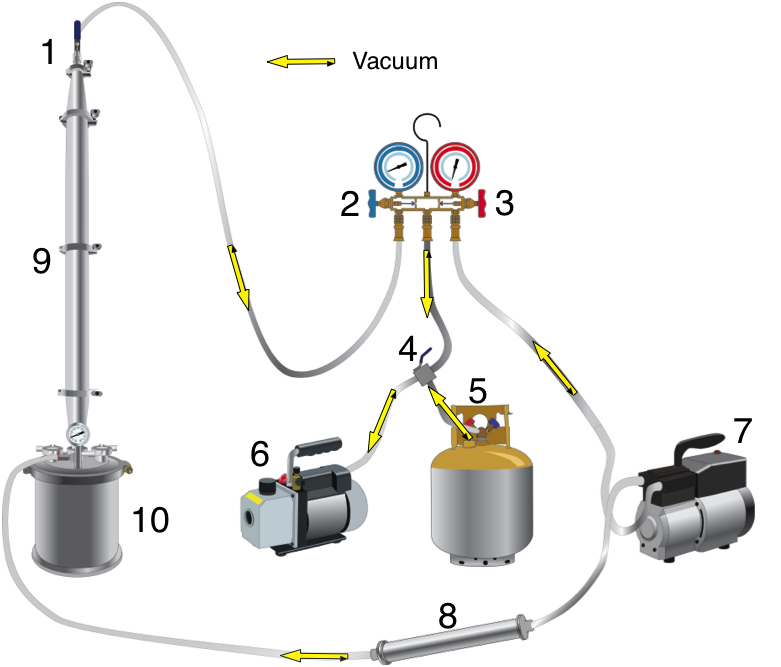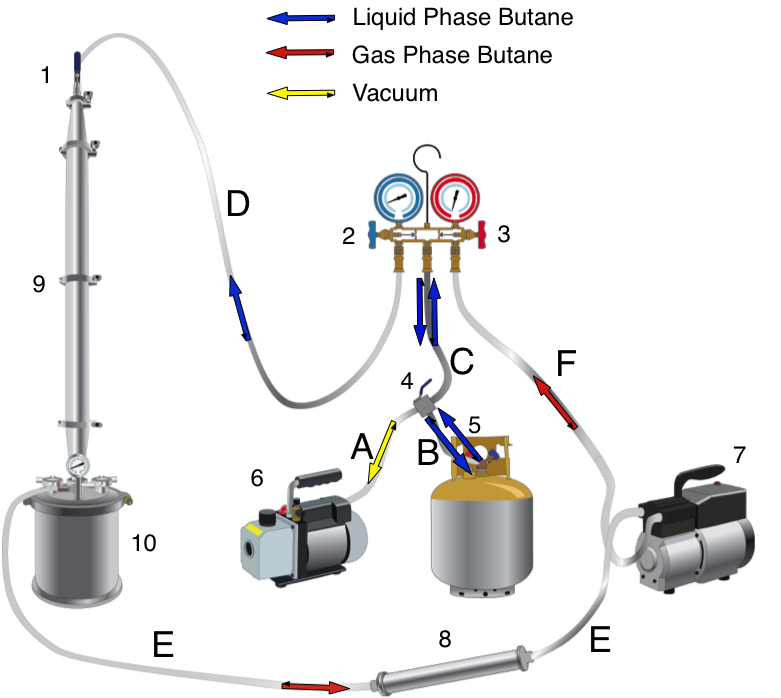There are two reasons to vacuum the extractor: 1. create negative pressure to “pull” the butane into the extractor; 2. remove oxygen from the extractor to prevent potential explosive conditions. Follow the steps below. One step at a time, you vacuum out each segment of the extractor. The chart will show you the open/closed condition of every valve or on/off switch as you work through the steps. 
| Step 1 – Pre-vacuum – turn on vacuum | ||||
| Component # | Component Name | Abbreviation | Open/On | Closed/Off |
| 1 | Extraction Column Valve | ECV | x | |
| 2 | Low Pressure Recovery Manifold | RM2 | x | |
| 3 | High Pressure Recovery Manifold | RM3 | x | |
| 4 | Purge Port | PP | x | |
| 5 | Recovery Cylinder | RC | x | |
| 6 | Vacuum Pump | VP | x | |
| 7 | Recovery Pump | RP | x | |
| Step 1.1 – Vacuum – open purge port (4) | ||||
| Component # | Component Name | Abbreviation | Open/On | Closed/Off |
| 1 | Extraction Column Valve | ECV | x | |
| 2 | Low Pressure Recovery Manifold | RM2 | x | |
| 3 | High Pressure Recovery Manifold | RM3 | x | |
| 4 | Purge Port | PP | x | |
| 5 | Recovery Cylinder | RC | x | |
| 6 | Vacuum Pump | VP | x | |
| 7 | Recovery Pump | RP | x | |
| Step 1.2 – Vacuum – close purge port (4) and open high pressure recovery manifold valve (3) | ||||
| Component # | Component Name | Abbreviation | Open/On | Closed/Off |
| 1 | Extraction Column Valve | ECV | x | |
| 2 | Low Pressure Recovery Manifold | RM2 | x | |
| 3 | High Pressure Recovery Manifold | RM3 | x | |
| 4 | Purge Port | PP | x | |
| 5 | Recovery Cylinder | RC | x | |
| 6 | Vacuum Pump | VP | x | |
| 7 | Recovery Pump | RP | x | |
| Step 1.3 – Vacuum – close high pressure recovery manifold valve (3) and open low pressure recovery manifold valve (2) | ||||
| Component # | Component Name | Abbreviation | Open/On | Closed/Off |
| 1 | Extraction Column Valve | ECV | x | |
| 2 | Low Pressure Recovery Manifold | RM2 | x | |
| 3 | High Pressure Recovery Manifold | RM3 | x | |
| 4 | Purge Port | PP | x | |
| 5 | Recovery Cylinder | RC | x | |
| 6 | Vacuum Pump | VP | x | |
| 7 | Recovery Pump | RP | x | |
| Step 1.4 – Vacuum – open extraction column valve (1) | ||||
| Component # | Component Name | Abbreviation | Open/On | Closed/Off |
| 1 | Extraction Column Valve | ECV | x | |
| 2 | Low Pressure Recovery Manifold | RM2 | x | |
| 3 | High Pressure Recovery Manifold | RM3 | x | |
| 4 | Purge Port | PP | x | |
| 5 | Recovery Cylinder | RC | x | |
| 6 | Vacuum Pump | VP | x | |
| 7 | Recovery Pump | RP | x | |
| Step 1.5 – Vacuum – Vacuum extractor to the maximum vacuum (~29″Hg) | ||||
| Component # | Component Name | Abbreviation | Open/On | Closed/Off |
| 1 | Extraction Column Valve | ECV | x | |
| 2 | Low Pressure Recovery Manifold | RM2 | x | |
| 3 | High Pressure Recovery Manifold | RM3 | x | |
| 4 | Purge Port | PP | x | |
| 5 | Recovery Cylinder | RC | x | |
| 6 | Vacuum Pump | VP | x | |
| 7 | Recovery Pump | RP | x | |
| Step 1.6 – Vacuum – close extraction column valve (1) and low pressure recovery manifold (2) | ||||
| Component # | Component Name | Abbreviation | Open/On | Closed/Off |
| 1 | Extraction Column Valve | ECV | x | |
| 2 | Low Pressure Recovery Manifold | RM2 | x | |
| 3 | High Pressure Recovery Manifold | RM3 | x | |
| 4 | Purge Port | PP | x | |
| 5 | Recovery Cylinder | RC | x | |
| 6 | Vacuum Pump | VP | x | |
| 7 | Recovery Pump | RP | x | |
| Step 1.7 – Vacuum – Wait 10 minutes and observe all pressure gauges for pressure drop, then check one valve at a time for pressure drop | ||||
| Component # | Component Name | Abbreviation | Open/On | Closed/Off |
| 1 | Extraction Column Valve | ECV | x | |
| 2 | Low Pressure Recovery Manifold | RM2 | x | |
| 3 | High Pressure Recovery Manifold | RM3 | x | |
| 4 | Purge Port | PP | x | |
| 5 | Recovery Cylinder | RC | x | |
| 6 | Vacuum Pump | VP | x | |
| 7 | Recovery Pump | RP | x | |
As always, if you have any questions please post them in the comments section. Your questions and time are valuable and we will make every attempt to help you through your process.

